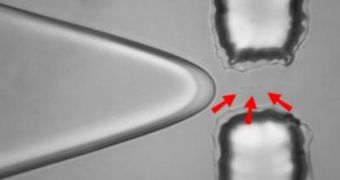Physicists Carlos Lopez-Mariscal and Kristian Helmerson, with the aid of the National Institute of Standards and Technology's (NIST) Center for Nanoscale Science and Technology, have recently devised a new method of encasing single molecules in microdroplets. The innovation will allow experts to devise and monitor chemical reactions taking place between individual molecules from substances of interest in the near future. Obtaining single-molecule information on the structure and function of important organic materials, such as proteins, enzymes, and DNA, is also now possible.
According to the team, this new, microfluidic, “droplet-on-demand” method could also be combined with “optical tweezers” (focused laser beams), in order to allow chemists to, for instance, combine several microdroplets, and analyze how the reactants contained within act at a single-molecule level. The new, microfluidic device features a single channel, in which water is inserted. As the liquid progresses through the path, the channel constantly gets narrower. Viscous oils are also placed inside, and their properties force the water into an even narrower constriction.
The sudden pressure drop the water experiences forces it to break apart into very small droplets, in a process similar to the one that can be noticed when a thin stream of water falling from a faucet breaks up into small drops. By adjusting the width of the constriction, the team has also found, the size of the droplets can be controlled. Additionally, it says, all of the droplets are highly uniform, which makes them especially suitable for scientific observations. In their experiments, the two physicists managed to obtain droplets just one micrometer in diameter, and half a billionth of a billionth of a liter in volume.
The chemicals are added in the microfluidic device as well, in the desired concentrations. On average, the droplets pick up just one molecule of the chemicals, and encase them inside. The molecule belonging to the substance is then held among the water molecules, which naturally make up most of the droplet's mass. Once the desired chemicals have been encased in their respective droplets, lasers can be used to make two microdroplets coalesce, and the chemicals react. Their interactions can be observed via classical, optical methods.

 14 DAY TRIAL //
14 DAY TRIAL //